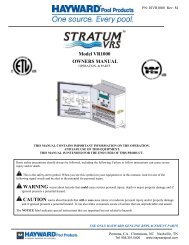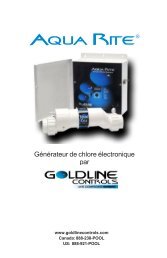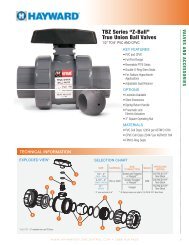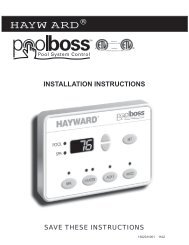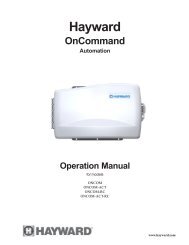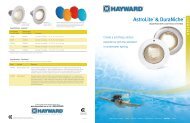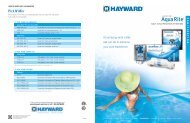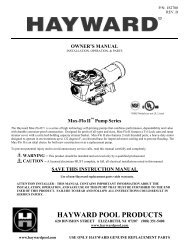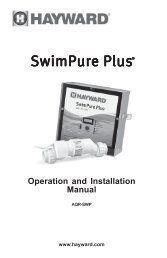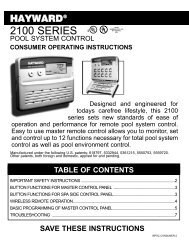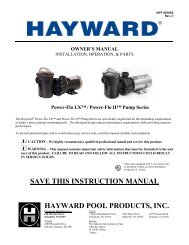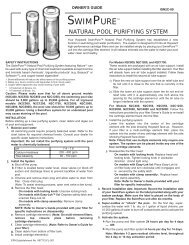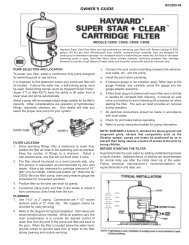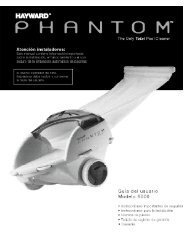Hayward Pro™ Series High-Rate Sand Filter - Model S310T ...
Hayward Pro™ Series High-Rate Sand Filter - Model S310T ...
Hayward Pro™ Series High-Rate Sand Filter - Model S310T ...
You also want an ePaper? Increase the reach of your titles
YUMPU automatically turns print PDFs into web optimized ePapers that Google loves.
I<strong>S310T</strong>-99<br />
MODEL <strong>S310T</strong><br />
Your <strong>Hayward</strong> Pro <strong>Series</strong> high-rate sand filter is a high<br />
performance, totally corrosion-proof filter that blends superior<br />
flow characteristics and features with ease of operation. It<br />
represents the very latest in high-rate sand filter technology.<br />
It is virtually foolproof in design and operation and when<br />
installed, operated and maintained according to instructions,<br />
your filter will produce clear, sparkling water with only the<br />
least attention and care.<br />
HOW IT WORKS<br />
Your filter uses special filter sand to remove dirt particles<br />
from pool water. <strong>Filter</strong> sand is loaded into the filter tank and<br />
functions as the permanent dirt removing media. The pool<br />
water, which contains suspended dirt particles, is pumped<br />
through your piping system and is automatically directed by<br />
the patented filter control valve to the top of the filter tank.<br />
As the pool water is pumped through the filter sand, dirt<br />
particles are trapped by the sand bed, and filtered out. The<br />
cleaned pool water is returned from the bottom of the filter<br />
tank, through the control valve and back to the pool through<br />
the piping system. This entire sequence is continuous and<br />
automatic and provides for total recirculation of pool water<br />
through your filter and piping system.<br />
After a period of time, the accumulated dirt in the filter<br />
causes a resistance to flow, and the flow diminishes. This<br />
means it is time to clean (backwash) your filter. With the<br />
control valve in the backwash position, the water flow is<br />
automatically reversed through the filter so that it is directed<br />
to the bottom of the tank, up through the sand, flushing the<br />
previously trapped dirt and debris out the waste line. Once<br />
the filter is backwashed (cleaned) of dirt, the control valve is<br />
manually resequenced to Rinse, and then <strong>Filter</strong>, to resume<br />
normal filtering.<br />
INSTALLATION<br />
Only simple tools (screwdriver and wrenches), plus pipe<br />
sealant for plastic adapters, are required to install and/or<br />
service the filter.<br />
1. The filter system should be installed, not more than 6<br />
feet above pool water level, on a level concrete slab,<br />
very firm ground, or equivalent, as recommended by<br />
your pool dealer. Position the filter so that the piping<br />
connections, control valve and winter drain are<br />
convenient and accessible for operation, service and<br />
winterizing.<br />
2. Assemble pump and pump mounting base, No.<br />
S160TPAK1 or S160TPAK3 (if supplied) to the filter<br />
according to instructions packed with the base.<br />
(62 cm)<br />
(117 cm)<br />
(122 cm)
SPECIFICATIONS<br />
MODEL<br />
EFFECTIVE<br />
FILTRATION AREA<br />
DESIGN<br />
FLOW RATE*<br />
PRESSURE LOSS AT<br />
DESIGN FLOW RATE*<br />
NUMBER FT 2 M 2 GPM LPM PSI BAR<br />
<strong>S310T</strong> 4.9 0.46 98 371 4.7 0.33<br />
*Based on 20 GPM/ft. 2 or 814 LPM/m 2 (maximum allowable NSF rating).<br />
MAXIMUM WORKING<br />
PRESSURE<br />
PSI BAR<br />
50 3.45<br />
REQUIRED CLEARANCE MEDIA REQUIRED<br />
SIDE ABOVE TYPE AMOUNT<br />
INCH MM INCH MM FILTER SAND** LBS KGS<br />
18 457 18 457 0.45-0.55 500 227<br />
**Also known as No. 20 or No. 1/2 Silica <strong>Sand</strong>.<br />
PARTS<br />
<strong>Model</strong> <strong>S310T</strong><br />
REF.<br />
NO.<br />
PART NO.<br />
DESCRIPTION<br />
NO.<br />
REQ’D.<br />
1a<br />
SP071113<br />
Vari-Flo Control Valve - 1-1/2”<br />
1<br />
1b<br />
SP071620<br />
Vari-Flo Control Valve - 2”<br />
1<br />
2<br />
ECX27081<br />
Pressure Gauge<br />
1<br />
3<br />
GMX600F<br />
Valve/Tank O-Ring<br />
1<br />
4<br />
SX310N<br />
Flange Clamp (Valve - Tank)<br />
1<br />
5<br />
SX202S<br />
<strong>Sand</strong> Shield<br />
1<br />
6<br />
SX310AA1<br />
<strong>Filter</strong> Tank with Skirt,<br />
Drain and Lateral Ass’y.<br />
1<br />
7 SX310DA<br />
Lateral Assembly with<br />
Center Pipe<br />
1<br />
8<br />
SX310HA<br />
Lateral<br />
10<br />
9<br />
SX180G<br />
Gasket<br />
1<br />
10<br />
SX180H<br />
Drain Cap<br />
1<br />
11<br />
SX310J<br />
<strong>Filter</strong> Support Stand (Skirt)<br />
1
3. Loading sand media. <strong>Filter</strong> sand media is loaded through<br />
the top opening of the filter.<br />
a. Loosen flange clamp and remove <strong>Filter</strong> Control Valve<br />
(if previously installed).<br />
b. Cap internal pipe with sand shield to prevent sand<br />
from entering it. Be sure pipe is securely in place in<br />
bottom underdrain hub.<br />
c. We recommend filling tank approximately 1/2 way with<br />
water to provide a cushioning effect when the filter<br />
sand is poured in. This helps protect the underdrain<br />
laterals from excessive shock. (Be sure the winter<br />
drain cap is securely in place on drain pipe).<br />
d. Carefully pour in correct amount and grade of filter<br />
sand, as specified. (Be sure center pipe remains<br />
centered in opening). <strong>Sand</strong> surface should be leveled<br />
and should come to about the middle of the filter tank.<br />
Remove sand shield from internal pipe.<br />
4. Assemble <strong>Filter</strong> Control Valve to filter tank.<br />
a. Place stainless steel valve flange clamp around neck<br />
of tank. Do not tighten. Wipe filter flange clean.<br />
b. Insert <strong>Filter</strong> Control Valve (with valve/flange O-ring in<br />
place) into the tank neck, taking care that the center<br />
pipe slips into the hole in the bottom of the valve.<br />
Place clamp around valve flange and tank flange just<br />
enough so that the valve may be rotated on tank for<br />
final positioning.<br />
c. Carefully screw pressure gauge, with pipe tape, into<br />
1/4” tapped hole in valve body. Do not overtighten.<br />
d. Connect pump to control valve opening marked PUMP<br />
according to instructions. After connections are made,<br />
tighten valve flange clamp with screwdriver, tapping<br />
around clamp with screwdriver handle to help seat<br />
valve flange clamp.<br />
5. Make return to pool pipe connection to control valve<br />
opening marked RETURN and complete other necessary<br />
plumbing connections, suction lines to pump, waste, etc.<br />
6. Make electrical connections to pump per pump<br />
instructions.<br />
7. To prevent water leakage, be sure winter drain cap is<br />
securely in place and all pipe connections are tight.<br />
INITIAL START-UP OF FILTER<br />
1. Be sure correct amount of filter sand media is in tank and<br />
that all connections have been made and are secure.<br />
2. Depress Vari-Flo control valve handle and rotate to<br />
BACKWASH* position. (To prevent damage to control<br />
valve seal, always depress handle before turning.)<br />
3. Prime and start pump according to pump instructions (be<br />
sure all suction and return lines are open), allowing the<br />
filter tank to fill with water. CAUTION: All suction and<br />
discharge valves must be open when starting the<br />
system. Failure to do so could cause severe<br />
personal injury and/or property damage. Once water<br />
flow is steady out the waste line, run the pump for at least<br />
2 minutes. The initial backwashing of the filter is<br />
recommended to remove any impurities or fine sand<br />
particles in the sand media.<br />
4. Turn pump off and set valve to RINSE position. Start<br />
pump and operate until water in sight glass is<br />
clear—about 1/2 to 1 minute. Turn pump off, set valve to<br />
FILTER position and restart pump. Your filter is now<br />
operating in the normal filter mode, filtering particles from<br />
the pool water.<br />
5. Adjust pool suction and return valves to achieve desired<br />
flow. Check system and filter for water leaks and tighten<br />
connections, bolts, nuts, as required.<br />
6. Note the initial pressure gauge reading when the filter is<br />
clean. (It will vary from pool to pool depending upon the<br />
pump and general piping system). As the filter removes<br />
dirt and impurities from the pool water, the accumulation<br />
in the filter will cause the pressure to rise and flow to<br />
diminish. When the pressure gauge reading is 8-10 PSI<br />
(0.55-0.69 BAR) higher than the initial “clean” pressure<br />
you noted, it is time to backwash (clean) the filter (see<br />
BACKWASH under <strong>Filter</strong> Control Valve Functions.)<br />
NOTE: During initial clean-up of the pool water it may<br />
be necessary to backwash frequently due to the<br />
unusually heavy initial dirt load in the water.<br />
IMPORTANT: To prevent unnecessary strain on piping<br />
system and valving, always shut off pump before<br />
switching <strong>Filter</strong> Control Valve positions.<br />
To prevent damage to the pump and filter and for proper<br />
operation of the system, clean pump strainer and skimmer<br />
baskets regularly.<br />
FILTER CONTROL VALVE FUNCTIONS<br />
FILTER—Set valve to FILTER for normal filtering. Also use for<br />
regular vacuuming.<br />
BACKWASH—For cleaning filter. When filter pressure gauge<br />
rises 8-10 PSI (0.55-0.69 BAR) above start-up (clean<br />
pressure):<br />
Stop the pump, set valve to BACKWASH. Start pump and<br />
backwash until water in sight glass is clear. Approximately 2<br />
minutes or less depending on dirt accumulation. Proceed to<br />
RINSE.<br />
RINSE—After backwashing, with pump off, set valve to RINSE.<br />
Start pump and operate for about 1/2 to 1 minute. This ensures<br />
that all dirty water from backwashing is rinsed out of the filter to<br />
waste, preventing possible return to the pool. Stop pump, set<br />
valve to FILTER, and start pump for normal filtering.<br />
WASTE—To bypass filter for draining or lowering water level<br />
and for vacuuming heavy debris directly to waste.<br />
RECIRCULATE—Water is recirculated through the pool<br />
system, bypassing the filter.<br />
CLOSED—Shuts off flow from pump to filter.<br />
VACUUMING—Vacuuming can be performed directly into the<br />
filter. When vacuuming heavy debris loads, set valve to<br />
WASTE position to bypass the filter and vacuum directly out to<br />
waste.<br />
*NOTE: For new concrete or gunite pools, or where there is a large amount of plaster dust or debris—start filter in FILTER position (not BACKWASH) to prevent clogging of<br />
underdrain laterals.
1.<br />
2.<br />
WINTERIZING<br />
Completely drain tank by unscrewing drain cap at base<br />
of filter tank. Leave cap off during winter.<br />
Depress Vari-Flo control valve handle and rotate so as to<br />
set pointer on valve top between any two positions. This<br />
will allow water to drain from the valve. Leave valve in<br />
this “inactive” position.<br />
PLEASE REALIZE. . .<br />
Pure, clear swimming pool water is a combination of two<br />
factors—adequate filtration and proper water chemistry<br />
balance. One without the other will not give the clean water<br />
you desire.<br />
Your filter system is designed for continuous operation.<br />
However, this is not necessary for most swimming pools.<br />
You can determine your filter operation schedule based on<br />
your pool size and usage. Be sure to operate your filtration<br />
3. Drain and winterize pump according to pump instructions.<br />
SERVICE & REPAIRS<br />
Consult your local authorized <strong>Hayward</strong> dealer or service<br />
center. No returns may be made directly to the factory<br />
without the expressed authorization of <strong>Hayward</strong> Pool<br />
Products, Inc.<br />
system long enough each day to obtain at least one<br />
complete turnover of your pool water.<br />
To properly sanitize your pool, maintain a free chlorine level<br />
of 1 to 3 ppm and a pH range of 7.2 to 7.6. Insufficient<br />
chlorine or an out of balance pH level will permit algae and<br />
bacteria to grow in your pool and make it difficult for your<br />
filter to properly clean the pool water.<br />
PROBLEM SOLVING LIST<br />
LOW WATER FLOW SHORT FILTER CYCLES POOL WATER WON’T CLEAR UP<br />
REMEDY<br />
1.<br />
2.<br />
3.<br />
Check skimmer and pump<br />
strainer baskets for debris.<br />
Check for restrictions in<br />
intake and discharge lines.<br />
Check for air leak in intake<br />
line (indicated by bubbles<br />
returning to pool).<br />
4. Backwash filter.<br />
1.<br />
2.<br />
3.<br />
Check for algae in pool and<br />
superchlorinate as required.<br />
Be sure chlorine and pH<br />
levels are in proper range<br />
(adjust as required).<br />
Check surface of filter sand<br />
for crusting or caking<br />
(remove 1” of sand if<br />
necessary).<br />
1.<br />
2.<br />
3.<br />
4.<br />
Check chlorine, pH and total<br />
alkalinity levels and adjust<br />
as required.<br />
Be sure flow rate through<br />
filter is sufficient.<br />
Operate filter for longer periods.<br />
Be sure Vari-Flo valve is set<br />
on “<strong>Filter</strong>” position.<br />
POOL CHEMISTRY GUIDELINES<br />
pH<br />
SUGGESTED POOL CHEMISTRY LEVELS<br />
TOTAL ALKALINITY<br />
CHLORINE (UNSTABILIZED)<br />
CHLORINE (STABILIZED)<br />
CHLORINE STABILIZER<br />
(Cyanuric Acid)<br />
7.2 to 7.6<br />
100 to 130 ppm<br />
0.3 to 1.0 ppm<br />
1.0 to 3.0 ppm<br />
40 to 70 ppm<br />
ACTION REQUIRED TO CORRECT POOL CHEMISTRY<br />
TO RAISE<br />
Add Soda Ash<br />
Add Sodium Bicarbonate<br />
Add Chlorine Chemical<br />
Add Chlorine Chemical<br />
Add Stabilizer<br />
TO LOWER<br />
Add Muriatic Acid or Sodium Bisulphate<br />
Add Muriatic Acid<br />
No action - chlorine will naturally dissipate<br />
No action - chlorine will naturally dissipate<br />
Dilution - partially drain & refill pool with water<br />
that has not been treated with Cyanuric Acid.<br />
Rev. 6/99 A<br />
©1999 <strong>Hayward</strong> Printed in U.S.A.



